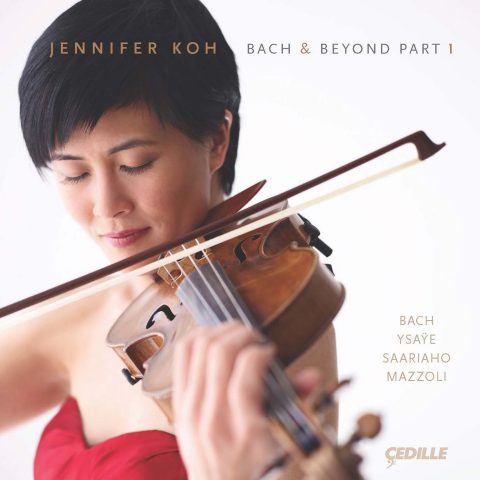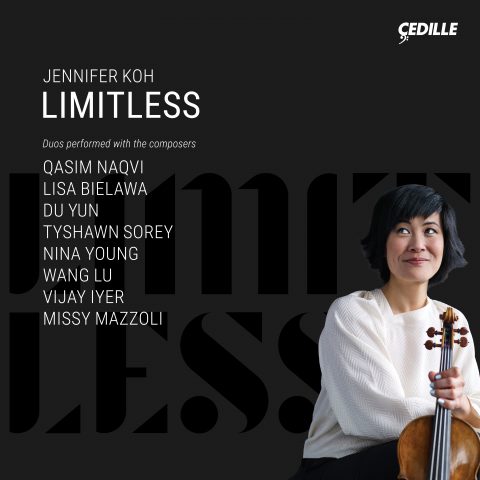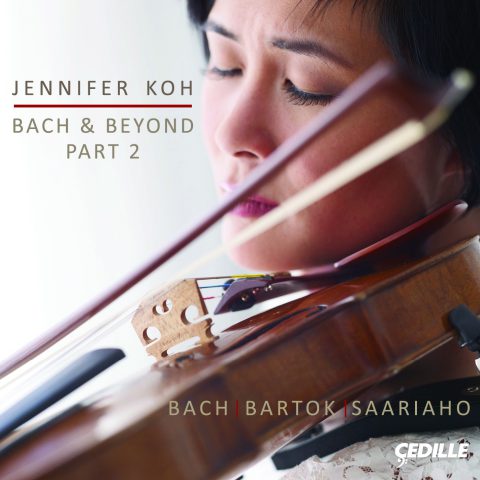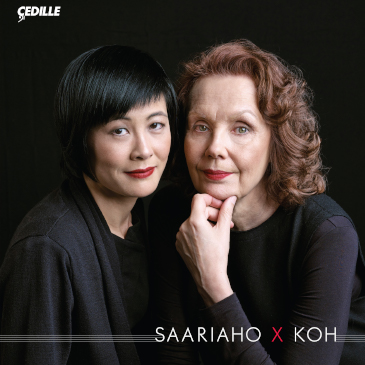Store
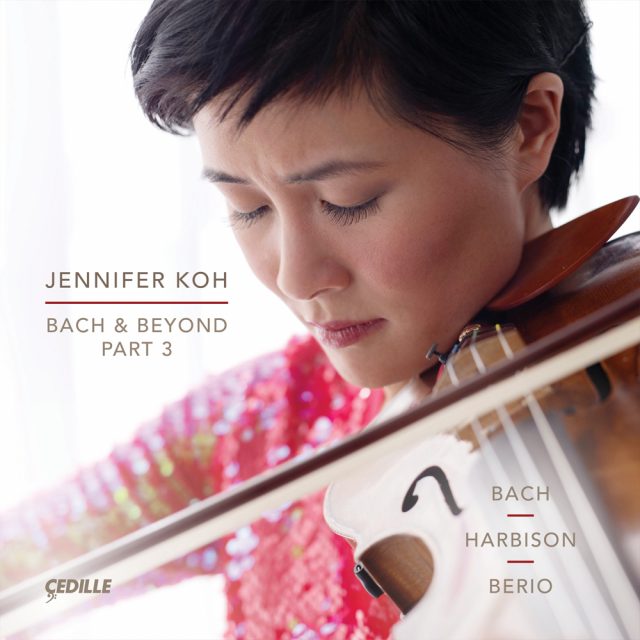
Jennifer Koh’s Bach & Beyond Part 3 concludes her critically acclaimed series of recordings based on her groundbreaking, multi-season recital series of the same name that The New York Times has called “indispensable.”
Koh, “a virtuoso with quirky and wonderful ideas” (San Francisco Chronicle), again pairs two of J.S. Bach’s landmark Sonatas and Partitas for solo violin with Bach-inspired 20th- and 21st-century works. On this series-finale album, Bach’s florid and fanciful Sonata No. 2 in A minor and Sonata No. 3 in C major, celebrated for its colossal Fuga movement, frame Luciano Berio’s expressive, chaconne-like Sequenza VIII and Pulitzer Prize winner John Harbison’s alluring For Violin Alone, a dance suite inspired by Bach’s partitas, written for Koh (a world-premiere recording).
Toronto’s The WholeNote said of Koh’s previous installment, Bach & Beyond Part 2, “Koh, as always, is superb, her intelligence and interpretation always matching her outstanding technique,” while the Newark Star-Ledger cited “her distinctive voice over a range of styles” in its praise of Bach & Beyond Part 1, which launched the series. Bach & Beyond Part 3 is Koh’s 14th Cedille Records album.

Listen to Jim Ginsburg’s interview
with Jennifer Koh on Cedille’s
Classical Chicago Podcast
Preview Excerpts
JOHANN SEBASTIAN BACH (1685–1750)
Sonata No. 2 in A minor, BWV 1003
LUCIANO BERIO (1925–2003)
Artists
Program Notes
Download Album BookletBach & Beyond Part 3
Notes by Patrick Castillo
The final installment of Jennifer Koh’s Bach & Beyond series of albums featuring music for solo violin was produced at a time of intensified solitude. As COVID-19 continues to ravage our global community, we remain isolated, staying home to ensure the health and safety of our neighbors, our loved ones, and ourselves.
“Sei solo,” proclaims the title page of Bach’s autograph manuscript to his Sonatas and Partitas for Solo Violin: “Six solos” — or, perhaps, “You are alone.” This poignant wordplay, largely dismissed by Bach scholars but intriguing nevertheless, is thought to refer to the composer’s solitude following the death of his wife, Maria Barbara. Bach dated the title page 1720, the year of her death. It may seem far-fetched to surmise that the Sonatas and Partitas are the widowed composer’s tombeau for his deceased wife; but consider, too, that the correct Italian for “six solos” is “sei soli.” Such an error in grammar would be a rare slip for an intellect as exacting as Bach’s.
Whatever his intention, Bach’s Sonatas and Partitas constitute a majestic monument to solitude. From a single melodic instrument, Bach fashions exquisite counterpoint and polyphony and conjures a kaleidoscopic array of instrumental textures and expressive characters. Each of the three Sonatas features a fugue, the form that, in refracting a modest fragment into a brilliant mosaic, most gloriously manifests Bach’s guiding compositional principle of “all from one and
all in one.”
The Grave that begins the Sonata No. 2 in A minor, BWV 1003, despite its sobriety, nevertheless glorifies the instrument with its florid, fanciful writing. A terse nine-note subject drives the stern Fuga, the Sonata’s center of gravity; Bach develops this figure in short order, with an urgency befitting the fugue’s austere character. A lovely Andante follows, offering the listener tender solace in the fugue’s wake. Here Bach spins music of beguiling sincerity, pacing the tuneful melody with a pulsing heartbeat of repeated notes. That pulse is transfigured in a motoric flow of 16th and 32nd notes in the Allegro finale.
A gently rocking, dotted-rhythm gesture blossoms, in wondrous fashion, into the opening Adagio of the Sonata No. 3 in C major, BWV 1005. This movement is one of those quiet miracles in Bach’s oeuvre (think of the C-major Prelude of the Well-Tempered Clavier or the opening of the First Cello Suite) in which a whole world comes into being from the most unassuming musical idea. The Adagio spawns one of the colossal accomplishments to be found among the six Sonatas and Partitas: the second movement Fuga stands nearly shoulder-to-shoulder with the D-minor Partita’s immortal Ciaccona. The fugue is, at first glance, a seemingly affable thing, but slowly overwhelms the listener with its immense expressive power (and the violinist with its demands on both virtuosity and sheer stamina). It is the most complex of the fugues among the three Sonatas, displaying the full gamut of contrapuntal techniques; halfway through, Bach restarts the engine with the subject in inversion. A bewitching Largo and fetchingly rustic Allegro assai finale complete the Sonata.
Bach’s homage to solitude finds a distant echo in John Harbison’s For Violin Alone, composed in 2019 for Jennifer Koh. For Harbison, Bach has been a vital spiritual forebear since his youth. In a lecture to Tanglewood students, Harbison described the assemblage of his musical cosmos:
Here is how it went for me: in adolescence Mozart string quintets and Bach cantatas, Stravinsky Symphony of Psalms, Bartók Concerto for Orchestra… Kern and Gershwin… Oscar Peterson, later Horace Silver… During college: more Stravinsky, some Hindemith and Dallapiccola. Bach and Mozart even more preponderant. Discovery of Monk and Parker.… After college:… Bach still central, due to my performances of over forty of his cantatas…
For Violin Alone bears a closer kinship to Bach’s Partitas than to the Sonatas. It comprises six movements and an Epilogue, 4 resembling the Baroque dance suite rather than the four-movement sonata da chiesa (church sonata) model of the three Sonatas. The opening movement, the assertive Ground — a series of five successive recurrences of a central theme, continuously varied — gives way to the first of the two Dance movements. At the work’s center are the featherweight Air, its sinewy melodic lines marked alternately semplice and grazioso, cantabile, and a contrasting March: a brash thing punctuated by misterioso, timido, and ansioso utterances.
Luciano Berio’s Sequenza VIII (1976) for solo violin is the eighth in the composer’s signature series of 14 works for different solo instruments (including voice). The Sequenzas, writes Berio scholar David Osmond-Smith, “[make] explicit Berio’s fascination with virtuosity, understood not merely as technical dexterity, but as a manifestation of an agile musical intelligence that relishes the challenge of complexity.”
Berio likened the composition of Sequenza VIII to “paying a personal debt to the violin, which to me is one of the most subtle and complex of instruments.… While almost all of the other Sequenzas develop to an extreme degree a very limited choice of instrumental possibilities, Sequenza VIII deals with a larger and more global view of the violin and can be listened to as a development of instrumental gestures.”
Berio’s paean to the violin likewise pays a debt to Bach. The composer writes:
Sequenza VIII is built around two notes (A and B), which — as in a chaconne — act as a compass in the work’s rather diversified and elaborate itinerary, where polyphony is no longer virtual but real, where the soloist must make the listener constantly aware of the history behind each instrumental gesture. Sequenza VIII, therefore, becomes inevitably a tribute to that musical apex that is the Ciaccona from Johann Sebastian Bach’s Partita in D minor, where — historically — past, present, and future violin techniques coexist.
With its connection to the Ciaccona, Berio’s Sequenza VIII makes for a fitting part of the ending to Jennifer Koh’s Bach & Beyond recording cycle, whose first installment was anchored by the Partita in D minor.
Album Details
Producer and Engineer Judith Sherman
Engineering and Editing Assistance Jeanne Velonis
Mastering Bill Maylone
Graphic Design Bark Design
Photos Juergen Frank
Recorded
Bach: Sonata No. 2 in A minor, BWV 1003 September 16–17, 2017, American Academy
of Arts and Letters, New York
Bach: Sonata No. 3 in C major, BWV 1005 September 8–9, 2019, Concert Hall of
the Performing Arts Center, SUNY Purchase, Purchase, NY
Berio: Sequenza VIII
September 17–18, 2017, American Academy of Arts and Letters, New York
Harbison: For Violin Alone
September 9–10, 2019, Concert Hall of the Performing Arts Center, SUNY Purchase, Purchase, NY
Publishers
Berio: Sequenza VIII © 1976 Universal Edition
Harbison: For Violin Alone © 2015 Associated Music Publishers, Inc. (BMI)
Cedille Records © 2020
CDR 90000 199
